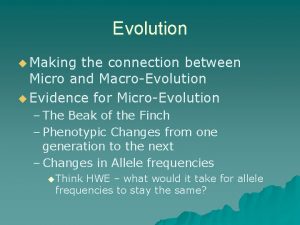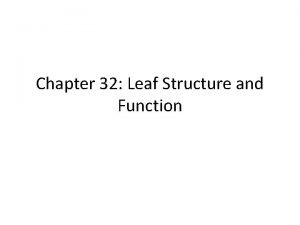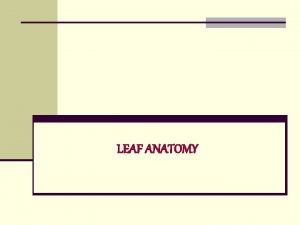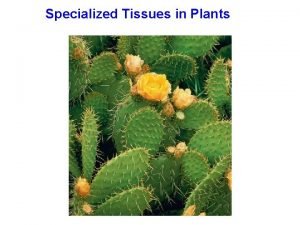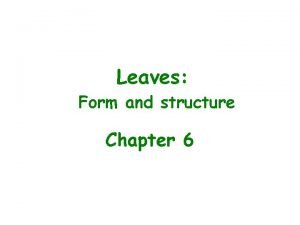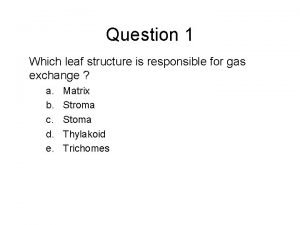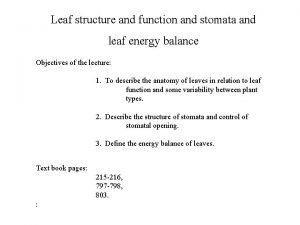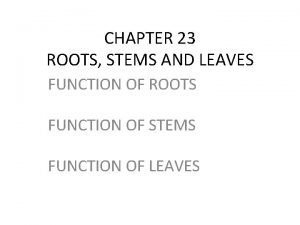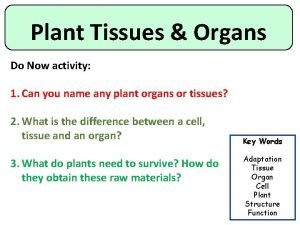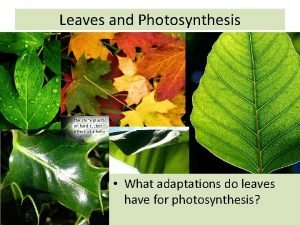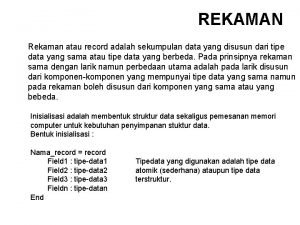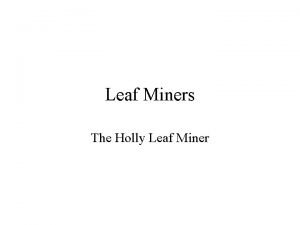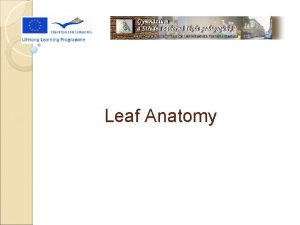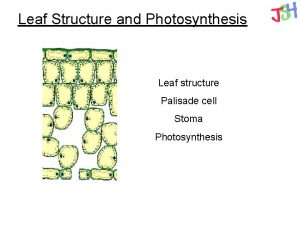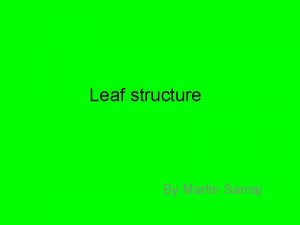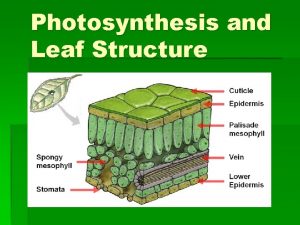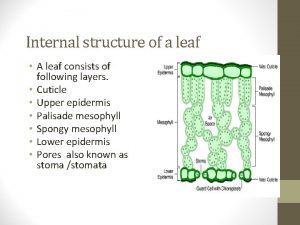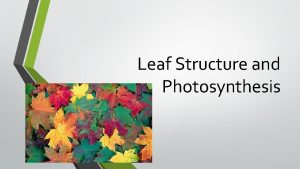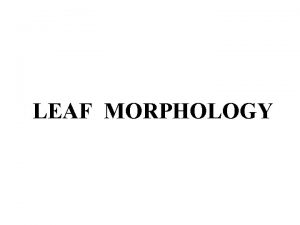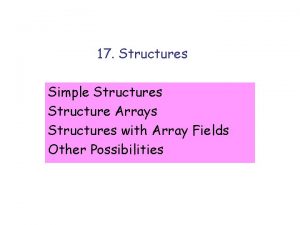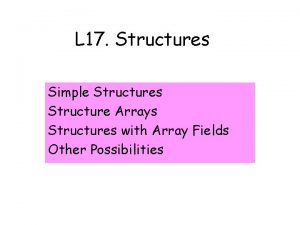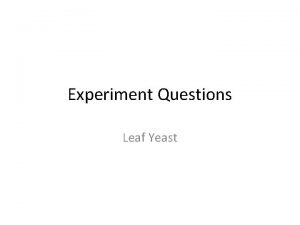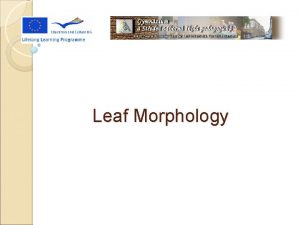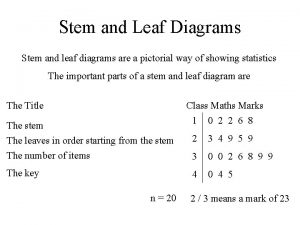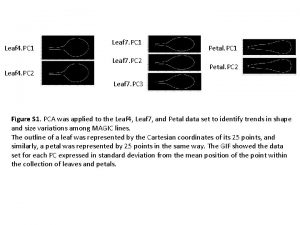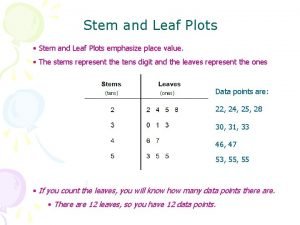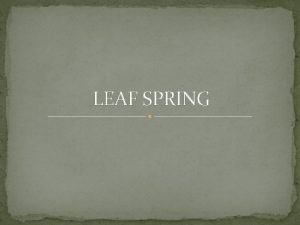Leaf structure Leaf Structures N O K C
























- Slides: 24

Leaf structure

Leaf Structures N O K C D I J L E M G F F G

Epidermal cells • Epidermal Cells –produce the waxy cuticle

Cuticle • Cuticle –waxy (non-cellular layer) • Protects against excessive water loss and infection • Restricts gas exchange • Deters herbivores

Palisade Mesophyll • Cells are tightly packed together with lots of chloroplasts • Primary site of photosythesis

Spongy Mesophyll • Cells are loosely arranged with air spaces in between them • Fewer chloroplasts • Promotes rapid gas diffusion (CO 2 and O 2)

Guard Cells • Guard Cells –size is depending on water content of plant • When full of water they push apart • When lacking water they come together • Control opening of stomata

Stomata • Stomata- pores in the epidermis • More located on lower surface • Where gas exchange takes place

Leaf Adaptations

Adaptations to SALT Mangrove Plants • Have special pores that excrete salt • Their leaves can tolerate to store high levels of salt • Restrict the openings of their stomata to preserve freshwater • Turn their leaves to reduce water loss


Adaptation to WATER Underwater plants • Leaves are flexible so they don’t break with currents • Air spaces in the leaf so they float (Hydrophilic) • Chlorophyll is restricted to the top layer

Adaptations to DRY • Hairs on the leaf trap humidity • Waxy leaf surface to reduce water loss • Succulent leaves store water • Spines have less surface area

Extreme heat • Example: Octillo • shed leaves when it gets to hot • lays dormant • lowers metabolism

Adaptations for DROUGHT i. Avoiders • Short lifespan • Wet season • Seeds survive drought • Drought deciduous species – Leaves shed in dry season

Adaptations for DROUGHT ii. Tolerators • Leaves transpire slowly • Change orientation of leaves • Sunken stomata – E. g. pines • More efficient photosynthesis

Adaptations in the RAINFOREST (Moist and shaded) • Waxy surfaces (drip tips) drain water to prevent fungal growth • Large surface area on leaves to absorb more light

Adaptations to BOREAL Cold and Dry • Extracellular freezing to protect cells • NEEDLE LEAVES • compact to protect vascular tissue • waxy cuticle protects the mesophyll & prevents water loss • prevent snow accumulation • Dark to absorb solar heat • Don’t shed = photosynthesis early in spring

Adaptations to the ARCTIC • Dark colours to absorb more solar heat • Covered in small hairs to conserve heat • Small surface area to prevent freezing

Adaptations to avoid BEING EATEN • Chemical Defence: • poison (poison ivy) • aromatic oils (eucalyptus) • alkaloids (tobacco) • Mechanical Defence • Spines / Thorns (ex: raspberry)

Hydrophytic

Mesophytic

xerophytic

Practice • Page 557 21 -23 • Page 559 12 -16
 Maple leaf and oak leaf homologous
Maple leaf and oak leaf homologous Leaf and non leaf procedure
Leaf and non leaf procedure Homologous
Homologous The structure of a leaf
The structure of a leaf Upper vs lower epidermis
Upper vs lower epidermis Leaf structure
Leaf structure Structure of leaf
Structure of leaf Internal structure of a leaf
Internal structure of a leaf Leaf structure questions
Leaf structure questions Structure of stomata diagram
Structure of stomata diagram Functions of stems
Functions of stems Leaf structure diagram
Leaf structure diagram What are the raw material needed for photosynthesis
What are the raw material needed for photosynthesis Physical state of covalent compounds
Physical state of covalent compounds Union myunion structure my structure integer m float n
Union myunion structure my structure integer m float n Giant molecular structure vs simple molecular structure
Giant molecular structure vs simple molecular structure Structural ambiguity exercises
Structural ambiguity exercises Competence vs performance in linguistics
Competence vs performance in linguistics Surface structure and deep structure
Surface structure and deep structure Giant molecular structure vs simple molecular structure
Giant molecular structure vs simple molecular structure Static data structures
Static data structures Recording data meaning
Recording data meaning Deep and surface structure
Deep and surface structure Dr frost averages
Dr frost averages Water movement in xylem
Water movement in xylem
